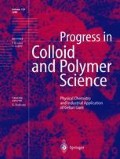Abstract
In aqueous/low-sugar systems it is considered that gellan gels are formed through the formation of double helices which further associate to form highly aggregated three-dimensional structures. In this study, large and small deformation measurements have been carried out on deacylated gellan gels in the presence of increasing levels of cosolute and the results are discussed in terms of the changing nature of the gel network. Large deformation measurements show a significant decrease in the gel modulus at 60% cosolute compared to gels with no added cosolute, accompanied by an increase in yield strain and yield stress and a decrease in the calcium required for maximum modulus.
This argues for limited aggregation of the polymer chains in the presence of the cosolute. Small deformation measurements show that in 80% cosolute cooling profiles are typical of a material that undergoes vitrification. The Williams—Landel—Ferry/ free-volume theory has been successfully applied to these high-sugar gellan gum systems. The application of this theory requires a lightly cross-linked system where the contribution to elasticity is mainly entropic. The importance of the polymer lies in the introduction of a new phase, the rubbery region, which vitrifies readily upon cooling, resulting in a higher glass-transition temperature than for the sugar alone. The variation of the relaxation distribution function with the time scale of the measurement shows a striking similarity between the biological materials studied here and synthetic polyisobutylene. We therefore envisage the gellan high-sugar system as a polymeric network of flexible disordered coils supported by occasional junction zones.
Access this chapter
Tax calculation will be finalised at checkout
Purchases are for personal use only
Preview
Unable to display preview. Download preview PDF.
References
Milas M, Rinaudo M (1996) Carbohydr Polym 30: 177–184
Sworn G, Kasapis S (1998) Carbohydr Res 309: 353–361
Evageliou V, Kasapis S, Hember MWN (1998) Polymer 39: 3909–3917
Al-Ruqaie IM, Kasapis S, Richardson RK, Mitchell G (1997) Polymer 38: 5685–5694
Ferry JD (1980) In: Viscoelastic properties of polymers. Wiley, New York, pp 264–320
Sworn G, Kasapis S (1998) Food Hydrocolloids 12: 283–290
Whittaker LE, Al-Ruqaie IM, Kasapis S, Richardson RK (1997) Carbohydr Polym 33: 39–46
Allen AT, Wood RM, McDonald MP (1974) Sugar Technol Rev 2: 165–180
Hemminga MA, Roozen MJGW, Walstra P (1993) In: Blanshard JMV, Lilford PJ (eds) The glassy state in foods. University of Nottingham Press, Nottingham, pp 157–172
Crescenzi V, Dentini M (1988) In: Phillips GO, Wedlock DJ, Williams PA (eds) Gums and stabilisers for the food Industry 4. IRL, Oxford, pp 63–69
Evageliou V, Kasapis S, Sworn G (1998) In: Williams PA, Phillips GO (eds) Gums and stabilisers for the food industry 9. The Royal Society of Chemistry, Cambridge, pp 333–344
Papageorgiou M, Kasapis S, Richardson RK (1994) Carbohydr Polym 25: 101–109
Williams ML, Landel RF, Ferry JD (1955) J Am Chem Soc 77: 3701–3706
Ferry JD, Fitzgerald ER (1954) In: Harrison VGW (ed) Proceedings of the 2nd international congress of rheology. Butterworth, London, pp 140–149
Ferry JD, Fitzgerald ER (1953) J Colloid Sci 8: 224–242
Author information
Authors and Affiliations
Editor information
Rights and permissions
Copyright information
© 1999 Springer-Verlag
About this paper
Cite this paper
Sworn, G., Kasapis, S. (1999). Molecular origins of the rheology of high-sugar gellan systems. In: Nishinari, K. (eds) Physical Chemistry and Industrial Application of Gellan Gum. Progress in Colloid and Polymer Science, vol 114. Springer, Berlin, Heidelberg. https://doi.org/10.1007/3-540-48349-7_17
Download citation
DOI: https://doi.org/10.1007/3-540-48349-7_17
Published:
Publisher Name: Springer, Berlin, Heidelberg
Print ISBN: 978-3-540-66389-8
Online ISBN: 978-3-540-48349-6
eBook Packages: Springer Book Archive

